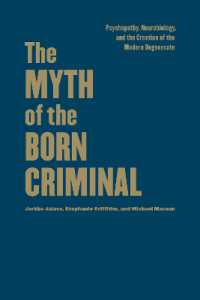Full Description
What can today's educational leaders do to create schools that are purposeful, moral, and successful? In this book, Glickman and Mette provide a powerful set of guidelines that will lead to true school renewal. Using a practical framework for school, district, and community leaders, their roadmap replaces dependence on top-down state and federal regulations, focusing instead on the creation of locally guided initiatives to address local goals. Filled with real-world examples, charts, and illustrations, the text gives teachers, principals, students, parents, central office personnel, school boards, and community members exactly what is needed to remake their schools. Building on Glickman's highly acclaimed classic, Renewing America's Schools (1993), this resource is must-reading for anyone involved with school change in today's divisive and complex times. Book Features:
Uses whole-school and classroom applications to explain how to implement the authors' three-part framework for school success.
Written in a clear, friendly, and accessible style.
Demonstrates in detail how purposeful schools can gain greater autonomy from strict external regulations.
Builds on its bestselling predecessor, Renewing America's Schools, to infuse democratic purpose and practices throughout a school.
Contents
Prologue ix
Preface xi
Acknowledgments xiii
1. Introduction: Recapturing the Essence of Schools 1
The Fork in the Road 1
Whipping American Public Schools with External Control 2
Being Real 3
Recapturing the Goal of American Public Schools 4
A Reframing of the Work 6
Ordinary Good People Doing Extraordinary Good Work 7
PART I: A RENEWED FRAMEWORK FOR DEMOCRATIZING SCHOOLS FROM THE INSIDE OUT
2. The Promise: Establishing Common Principles of Teaching and Learning 11
Schools as Successful Organizations 12
Traditions of (Mis)Education 15
Existing Conditions as a Forum for Discussion: Types of Schools 17
Developing the Promise 19
Principles of Learning 21
What to Do with the Promise 23
3. The Pledge: Creating a Commitment to Make Decisions as a Community 24
Developing a Decisionmaking Process 25
Guiding Rules of Decisionmaking 25
Locus of Control 26
Factors Impacting Democracy in Schools 27
The Ideal Governing Rules 29
Navigating Between Ideal and Reality 32
What Type of Governance? 33
Representative, Direct, and Hybrid Governance 34
Why Do This? 35
If Not Us, Then Whom? 37
Focus on Governance 38
A Final Note About Formality and Procedures 38
4. Problem Solving: Community-Based Action Research to Drive Student Learning 40
The Critical Self-Study Process 41
Raising Community-Based Questions to Drive Action Research 41
Data Sources for Self-Study 42
An American Tendency: Action Without Study 45
Infusion of Information 46
Ways to Gather Information 47
Giving Voice 49
PART II: THE WORK OF SCHOOL RENEWAL
5. Educational Priorities and Organizational Application 53
Curriculum Development and Implementation 54
Staff Professional Development 56
Instructional Coaching 57
Student Assessment and Outcomes 58
Instructional Resources 59
Implementing New Practices 61
Stages of Concern 62
Blurring of Tasks 63
Departmental and Grade-Level Plans 64
6. Becoming an Educative Community 66
Change and the Shadows of Our Own Caves 66
Understanding (De)Motivating Factors: Approaches to School Change 67
Developmental Needs 69
Sociocultural Differences 71
Getting Started 73
The Need to Identify and Act on Inequity 74
7. Dealing with Tough Questions of Practice 75
With Freedom Comes Responsibility 76
Moral Authority; Not Imposed Formal Authority 79
Diversification vs. Competition 80
The Ability of a Principal to Mobilize 82
Opportunities to Engage the Larger Community 83
Why Opportunities Are at the Heart of Renewing American Schools 84
The Continuum of Renewal 86
8. Supporting School Renewal: Important Signals from the District 88
The Politics of a School Board and District Personnel 88
Opportunities to Empower 89
An Age-Old Issue: Equality vs. Equity 91
Democratic Use of Economic Principles 92
Developing a District Plan for School Renewal 93
Fade Away or Facilitation? 96
Issues in Developing District Policies 96
The Morality of Decentralization 98
PART III: MOVING BEYOND IDEAS AND INTO ACTION
9. Dilemmas of Good Schools: Pinpointing and Moving On 103
The Issue of Time 103
External Regulations 104
Voice 106
Coordinating with Other Schools 108
Dependence on External Authorities 109
Sequence, Emphasis, and the Pace of Educational Change 110
Dysfunctional Behavior 112
Dilemmas and Decisions 114
10. Conclusion: If Not Now, Then When? 115
How to Take This Book and Run with It 116
Restructuring Policy 118
A Sobering Appraisal of the Need to Focus 119
Believing 120
Appendix A: Sample Pledge to Democratic Governance 123
Appendix B: The Peakview School Pledge 129
Appendix C: A Sample of a Process for Decentralizing Authority to Local Schools by a District and State Invitational Policy 131
References 135
Index 139
About the Authors 145








